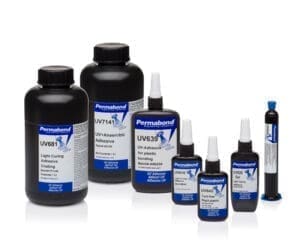Many types of adhesives bond polystyrene. However, it can be vulnerable to stress cracking, so take care in the adhesive selection, joint design, and adhesive cure process.
Polystyrene Properties:
Surface energy: 41mJ/m²
Maximum service temperature: 65°C
Softening temperature: 107°C
How to bond polystyrene?
Polystyrene can generally be bonded as received without cleaning. If cleaning is needed, clean with isopropanol or other mild cleaners. Solvents such as acetone can attack polystyrene.
When designing the joint to be bonded, consider putting a stop or control into the joint to avoid over-inserting one piece into another, which can create hoop stresses and develop stress cracking over time.
Regarding process – avoid long dwell times of adhesive before curing and avoid excess adhesive on-part to minimize the potential of stress cracking.
Adhesives that bond well include:

Two component epoxies bond well to polystyrene. Permabond ET500 is a clear non-yellowing epoxy with a fast set time.
UV Curable – UV Curable adhesives are an excellent choice for bonding polystyrene. Permabond UV630 and Permabond UV640 provide resilience to the joint as the elongation of both adhesive is greater than 110%. Permabond UV630 is low viscosity and UV 640 is medium viscosity.